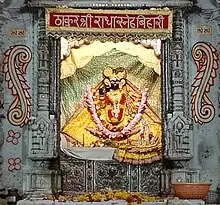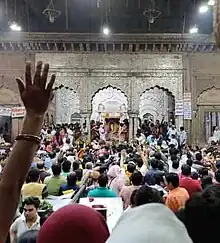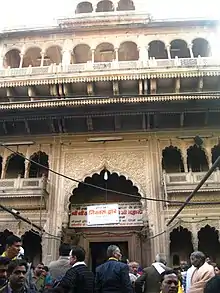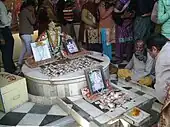| Banke Bihari Temple | |
|---|---|
Kunj Bihari Temple | |
 Banke Bihari, a combined form of Radha Krishna at Banke-Bihari temple, Vrindavan | |
| Religion | |
| Affiliation | Hinduism |
| District | Mathura |
| Deity | Banke Bihari (Radha and Krishna) |
| Festivals | Janmashtami, Radhashtami, Holi, Sharad Purnima, Karthik Purnima |
| Location | |
| Location | Vrindavan |
| State | Uttar Pradesh |
| Country | India |
 Location in Uttar Pradesh | |
| Geographic coordinates | 27°34′47″N 77°41′26″E / 27.57976°N 77.69051°E |
| Architecture | |
| Type | Rajasthani |
| Completed | 1862[1] |
| Elevation | 169.77 m (557 ft) |
| Website | |
| bankeybihari bihariji | |
| Part of a series on |
| Vaishnavism |
|---|
 |
Banke Bihari Temple is a Hindu temple situated in the town of Vrindavan, Mathura district of Uttar Pradesh, India. The temple is dedicated to Banke Bihari who is believed to be the combined form of Radha and Krishna. Banke Bihari was originally worshipped at Nidhivan, Vrindavan. Later, when Banke Bihari temple was constructed around 1864, the icon of Banke Bihari was moved to its present temple.[2][3]
In Banke Bihari temple, the icon of Radha Krishna's united form stands in the Tribhanga posture. Swami Haridas originally worshipped this murti under the name of Kunj Bihari which means the one who enjoys in the groves or Kunj of Vrindavan.[4]
History

The icon of Banke Bihari is believed to be the combined form of the divine couple Radha Krishna. The icon was manifested by Vrindavan musician and saint Swami Haridas who was believed to be the incarnation of Lalita gopi, a close associate of Radha Krishna in their celestial abode Goloka.[5] Swami Haridas was the guru of the famous singer Tansen.
According to the popular belief, once on the request of his disciples, Swami Haridas sang the following verse in Nidhivan in the praise of divine couple Shyama Shyam (Radha Krishna).
Mai ri sahaj jori pragat bhai ju,
Rang ki gaur shyam ghan damini jaisen,
Pratham hun ahuti ab hun aagen hun,
Rahihai na tarihai taisain,
Ang ang ki ujraii sugharaii,
Chaturai sunderta aisain,
Shri Haridas ke swami shyama,
Kunj bihari sam vais vaisain— Swami Haridas
On listening the verse, the celestial couple Shyama-Shyam (Radha Krishna) appeared in front of him and at the request of Swami Haridas, the divine couple merged into one and the stone image of Banke Bihari appeared in front of him. The icon was named Kunj Bihari or Banke Bihari by Swami Haridas and later the same icon was shifted from Nidhivan to Banke Bihari temple, Vrindavan.[5]
In scriptures
'Bānke' means 'bent', and 'Bihāri' or 'Vihāri' means 'enjoyer'. This is how Kṛiṣhṇa, who is bent in three places, got the name "Bānke Bihāri". According to Śrī Brahma-saḿhitā (verse 5.31), Brahma says the following about Kṛishna
"I worship Govinda, the primeval Lord, round whose neck is swinging a garland of flowers beautified with the moon-locket, whose two hands are adorned with the flute and jewelled ornaments, who always revels in pastimes of love, whose graceful threefold-bending form of Śyāmasundara is eternally manifest."[6][7]
Rituals
.JPG.webp)
In Banke Bihari temple, Banke Bihari is worshiped in the form of a small child. Thus, no early morning aarti is performed and no bells are hanged anywhere inside the temple premises as it may create the disturbance to Banke Bihari. Only on the occasion of Krishna Janmashtami, mangala aarti (early morning aarti) is performed. Curtains are drawn closed repeatedly in every five minutes to avoid the uninterrupted darshan of Banke Bihari as according to the popular belief if darshans are not interrupted, Banke bihari may accompany devotees to their homes, leaving temple empty. Only once a year, Banke Bihari holds the flute in his hands which is on the occasion of Sharad Purnima.[8][9]
Gallery
 Entrance of Banke Bihari Temple
Entrance of Banke Bihari Temple Nidhivana
Nidhivana Bankey Bihari Temple gate, sideview
Bankey Bihari Temple gate, sideview Garland sellers outside Banke Bihari Temple
Garland sellers outside Banke Bihari Temple
See also
References
- ↑ Glory project of Bihar, ISKCON PATNA, developed by Mahesh K Sanatan. "Temple History & Bihari Ji Appearance in Nidhivan - Shri Shri Banke Bihari, Vrindavan Dham". www.bankeybihari.info. Retrieved 9 June 2017.
{{cite web}}: CS1 maint: multiple names: authors list (link) - ↑ "Visit Banke Bihari Temple". Retrieved 18 July 2020.
- ↑ Rājaśekhara Dāsa (2000). The Color Guide to Vṛndāvana: India's Most Holy City of Over 5,000 Temples. Vedanta Vision Publication.
- ↑ "Shri Banke Bihari | District Mathura, Government of Uttar Pradesh | India". Retrieved 22 June 2023.
- 1 2 "Shri Banke Bihari ji Temple Vrindavan - site". bihariji.org.
- ↑ pnd (1 January 2012). "Bs 5.31". www.vedabase.com. Retrieved 9 June 2017.
- ↑ Brahma Samhita (in Sanskrit).
- ↑ Inspired, Be (2 October 2022). "Essential Guide to Banke Bihari Temple Vrindavan 2022". Retrieved 22 June 2023.
- ↑ Bansal, Sunita Pant (2008). Hindu Pilgrimage. Pustak Mahal. ISBN 978-81-223-0997-3.
External links
- Official website
- Shri Bankey Bihari Temple -thedivineindia.com
- Official Banke Bihari Temple Online Darshan Registration
Banke Bihari Meaning-theagranews.com
